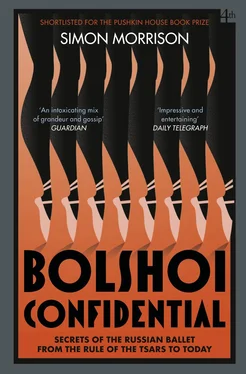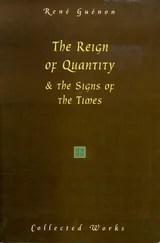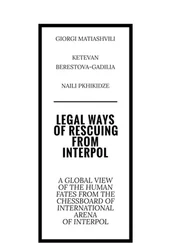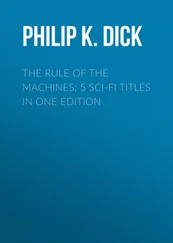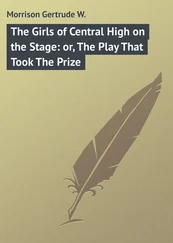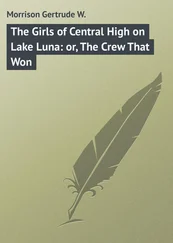The history of the Bolshoi travels hand in hand with the history of the nation. As goes Russia, so goes the Bolshoi—at least since the Russian Revolution, when the seat of power moved from St. Petersburg to Moscow. Under the tsars in the imperial capital of St. Petersburg, the Mariyinsky Theater (also known as the Kirov Theater) possessed the most prestige; the city of Moscow and its precariously financed ballet and opera house were considered provincial. But depending on who is looking and from where, one theater, one city, one lineage or another might appear in the foreground of a long tradition. In the twentieth century, the Bolshoi assumed pride of place within Russia and on the international stage as the emissary not only of the Russian ballet tradition but also the Soviet state. Bodies speak in Realpolitik. Russian ballet does not privilege abstraction, and those choreographers who, on limited occasion, sought to create non-narrative, non-subjective works erred in imagining that abstraction could be assigned whatever concepts they desired. Looking at the video records of today and sifting through the archival remains of yesteryear affirm that neither the dance nor the music attached to it is, or ever was, considered pure. Boldness and the projection of power are essential to politics and culture, especially within the context of President Vladimir Putin’s aggressive nationalist posturing. Today the Bolshoi seeks to regain the preeminence it forfeited after the collapse of the Soviet Union.
Within Russia, from the vaguely defined time of the nation’s founding, the rulers of Russia—tsars, Bolshevik revolutionaries, Stalin and his henchmen, the siloviki (members of the military-security establishment) of the current petro-ruble regime—have looked to the Bolshoi as a symbol, whether imperial, ideological, or commercial. The theater is about as old as the United States, but has had numerous lives. With Catherine the Great’s blessing, a Russian prince and an English showman first raised it up from the marshes of Moscow in 1780 on a plot of land close to the Kremlin; the start-up theater and the seat of goverment have been neighbors through several catastrophes. And fittingly so, given that in Russia politics can be theater and theater, politics.
After a fire in 1853, architect Alberto Cavos turned the Bolshoi into a stone neoclassical paradise of fluted columns, fitted mirrors, and alabaster vases; a sculpture of the Greek muses was installed above the portico. Following the Revolution of 1917, the Bolsheviks considered blowing up the Bolshoi as a decadent icon of the Russian imperial past but pillaged it instead, pulling up the marble floor and painting over the frescoes. The theater became a cultural symbol of the new state, which soon enough had imperial ambitions of its own; indeed, the Soviet Union itself was born at the Bolshoi. On December 30, 1922, it hosted the political congress that voted the Soviet Union into existence.
Stalin ratified the Soviet constitution on the stage of the Bolshoi and delivered speeches before cowed Communist Party officials; no one wanted to be the first to stop applauding. Thereafter it became the site of much Communist Party business, and even served as a polling station until a suitable palace was built inside the walls of the Kremlin. The Bolshoi was the single place where the rulers of Russia and their subjects came into contact. As one Kremlinologist explains, “To put in an appearance in the Bolshoi Theater meant that you belonged to the very highest echelons of power; but to disappear from there was synonymous with a fall from favor and death.” 1At the Bolshoi, ballets began after speeches delivered by officials who had overseen mass murders—the execution, on a staggering scale, of perceived saboteurs, traitors, anti-Soviet “fifth columnists,” and other undesirables. “Those who sat on the stage,” historian Karl Schlögel reports, “had appended their signatures to the thousands of death sentences approved by the extraordinary commissions and had even become directly involved themselves—in interrogations and the use of physical force.” 2
The repertoire of the State Academic Bolshoi Theater, as it became known, fell under Communist Party control. Its general directors were ordered to produce ballets and operas on approved Soviet subjects. Bulldozers rumbled across the stage to represent the construction of the Communist utopia before audiences of peasants and workers who had to be told when to clap. In 1939, the character of Lenin even appeared onstage in an agitprop opera called V buryu , or Into the Storm. A photograph from that era shows laborers listening to a performance of Tchaikovsky by way of celebrating the twentieth anniversary of Lenin’s secret police. For those directors who could not countenance ballets and operas about collective farms and hydroelectric stations, hewing close to the classics became the one safe, government-sanctioned alternative.
During World War II, part of the foyer of the theater was destroyed by a German bomb. Repairs were done on the postwar cheap, but the acoustics had earlier been compromised by Stalin, who had ordered the tsar’s loge at the center of the first tier encased in protective cement. (A document ordering the special reinforcement was reportedly buried in the wall.) In the 1980s, the Bolshoi fell apart along with the Soviet Union, but the power and majesty of Russian ballet remained, broadcast to the masses as the last vestige of national pride in the bankrupt munitions plant known as the USSR.
WHEN HE SIGNEDa five-year contract as artistic director of the Bolshoi in 2011, Filin was the forty-year-old prince of Russian ballet. A Moscow native, he had built a high-profile career as a principal dancer at the Bolshoi and been decorated as a People’s Artist of the Russian Federation, the nation’s highest artistic honor. His parents were not especially interested in ballet but, seeking to channel the boy’s restlessness, arranged for him to learn folk dance. His energy immediately found focus, and at ten years old Filin entered the Bolshoi Ballet Academy, graduating eight years later to claim a position in the professional company. Filin performed his first major role as the impish knave Benedick in Love for Love , a balletic adaptation of Shakespeare’s Much Ado About Nothing. The dance, set to music by Tikhon Khrennikov, is perhaps deservedly forgotten, but the experience sparked Filin’s enduring fascination with Shakespeare. The image that he had of himself as a dancer destined for greatness was tempered by Marina Semyonova, his professional coach. She died in 2010 at age 102, the Bolshoi tradition incarnate. During her final decades, she pushed her pupils to overcome the strictures of the Bolshoi style as preached and practiced during the late Soviet period. Filin has singled her out as his most important mentor and confidante. Semyonova told him “things that she didn’t share with anyone,” and even guided his personal life, cheekily advising him not to marry “this one” or “that one” owing to supposedly “misshapen” limbs or low breeding. 3
What made Filin a star was chiefly his range: the spectrum he could span between technical displays (as in Don Quixote , one of the buttresses of the Bolshoi repertoire), poetic expressiveness, and subtle characterizations. His good looks in his twenties made him perfect for the part of a gadabout, a pleasure seeker; experimental roles came later. Injury forced him from the stage in 2004, but he battled back into the spotlight while also completing a degree at Moscow University in the performing arts. In 2008, at age thirty-seven, he became the artistic director of the Stanislavsky Theater in Moscow; three years later, he was appointed to the same position at the Bolshoi. His job, basically second in command to then general director Anatoliy Iksanov, gave him control over repertoire, casting, appointments, and dismissals. It was a sensible choice. Filin knew the theater and its traditions intimately. Plus he was easygoing, not a firebrand.
Читать дальше
